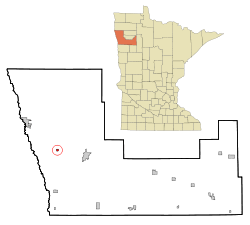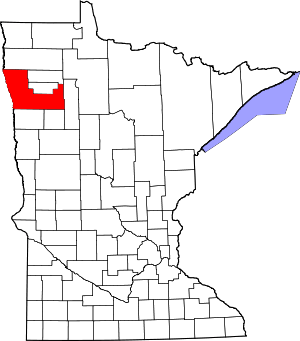Fisher, Minnesota
Fisher is a town in Polk County, Minnesota, United States. It is part of the Grand Forks-ND-MN Metropolitan Statistical Area. The population was 435 at the 2010 census.[5] Fisher has become a bedroom community for the nearby Greater Grand Forks Metropolitan Area.
Fisher | |
|---|---|
Downtown Fisher | |
 Location of Fisher, Minnesota | |
| Coordinates: 47°48′N 96°48′W | |
| Country | United States |
| State | Minnesota |
| County | Polk |
| Metro | Greater Grand Forks |
| Area | |
| • Total | 0.43 sq mi (1.10 km2) |
| • Land | 0.43 sq mi (1.10 km2) |
| • Water | 0.00 sq mi (0.00 km2) |
| Elevation | 846 ft (258 m) |
| Population | |
| • Total | 435 |
| • Estimate (2019)[3] | 419 |
| • Density | 983.57/sq mi (379.77/km2) |
| Time zone | UTC-6 (Central (CST)) |
| • Summer (DST) | UTC-5 (CDT) |
| ZIP code | 56723 |
| Area code(s) | 218 |
| FIPS code | 27-21158 |
| GNIS feature ID | 0643704[4] |
History
The city took its name from a local riverboat landing named for William H. Fisher, a railroad official.[6]
Geography
According to the United States Census Bureau, the city has a total area of 0.43 square miles (1.11 km2), all of it land.[7]
Demographics
| Historical population | |||
|---|---|---|---|
| Census | Pop. | %± | |
| 1880 | 239 | — | |
| 1890 | 481 | 101.3% | |
| 1900 | 410 | −14.8% | |
| 1910 | 328 | −20.0% | |
| 1920 | 305 | −7.0% | |
| 1930 | 297 | −2.6% | |
| 1940 | 333 | 12.1% | |
| 1950 | 302 | −9.3% | |
| 1960 | 326 | 7.9% | |
| 1970 | 383 | 17.5% | |
| 1980 | 453 | 18.3% | |
| 1990 | 395 | −12.8% | |
| 2000 | 435 | 10.1% | |
| 2010 | 435 | 0.0% | |
| Est. 2019 | 419 | [3] | −3.7% |
| U.S. Decennial Census[8] 2018 Estimate[9] | |||
2010 census
As of the census[2] of 2010, there were 435 people, 180 households, and 114 families living in the city. The population density was 1,011.6 inhabitants per square mile (390.6/km2). There were 196 housing units at an average density of 455.8 per square mile (176.0/km2). The racial makeup of the city was 97.9% White, 0.2% African American, 0.9% Native American, 0.7% from other races, and 0.2% from two or more races. Hispanic or Latino of any race were 4.6% of the population.
There were 180 households, of which 35.6% had children under the age of 18 living with them, 50.6% were married couples living together, 8.3% had a female householder with no husband present, 4.4% had a male householder with no wife present, and 36.7% were non-families. 29.4% of all households were made up of individuals, and 13.9% had someone living alone who was 65 years of age or older. The average household size was 2.42 and the average family size was 3.07.
The median age in the city was 32.2 years. 25.7% of residents were under the age of 18; 11.5% were between the ages of 18 and 24; 28.5% were from 25 to 44; 19.5% were from 45 to 64; and 14.7% were 65 years of age or older. The gender makeup of the city was 50.3% male and 49.7% female.
2000 census
As of the census of 2000, there were 435 people, 177 households, and 120 families living in the city. The population density was 1,092.3 people per square mile (419.9/km2). There were 197 housing units at an average density of 494.7 per square mile (190.2/km2). The racial makeup of the city was 98.62% White, 1.15% from other races, and 0.23% from two or more races. Hispanic or Latino of any race were 2.30% of the population.
There were 177 households, out of which 28.8% had children under the age of 18 living with them, 52.0% were married couples living together, 12.4% had a female householder with no husband present, and 32.2% were non-families. 26.6% of all households were made up of individuals, and 14.7% had someone living alone who was 65 years of age or older. The average household size was 2.46 and the average family size was 2.93.
In the city, the population was spread out, with 26.0% under the age of 18, 7.8% from 18 to 24, 29.0% from 25 to 44, 22.3% from 45 to 64, and 14.9% who were 65 years of age or older. The median age was 37 years. For every 100 females, there were 99.5 males. For every 100 females age 18 and over, there were 98.8 males.
The median income for a household in the city was $38,750, and the median income for a family was $49,444. Males had a median income of $32,656 versus $20,208 for females. The per capita income for the city was $19,083. About 5.5% of families and 6.8% of the population were below the poverty line, including 13.5% of those under age 18 and 3.3% of those age 65 or over.
References
- "2019 U.S. Gazetteer Files". United States Census Bureau. Retrieved July 26, 2020.
- "U.S. Census website". United States Census Bureau. Retrieved 2012-11-13.
- "Population and Housing Unit Estimates". United States Census Bureau. May 24, 2020. Retrieved May 27, 2020.
- "US Board on Geographic Names". United States Geological Survey. 2007-10-25. Retrieved 2008-01-31.
- "2010 Census Redistricting Data (Public Law 94-171) Summary File". American FactFinder. U.S. Census Bureau, 2010 Census. Retrieved 23 April 2011.
- Upham, Warren (1920). Minnesota Geographic Names: Their Origin and Historic Significance. Minnesota Historical Society. p. 424.
- "US Gazetteer files 2010". United States Census Bureau. Archived from the original on January 12, 2012. Retrieved 2012-11-13.
- United States Census Bureau. "Census of Population and Housing". Retrieved September 11, 2013.
- "Population Estimates". United States Census Bureau. Retrieved June 8, 2018.
